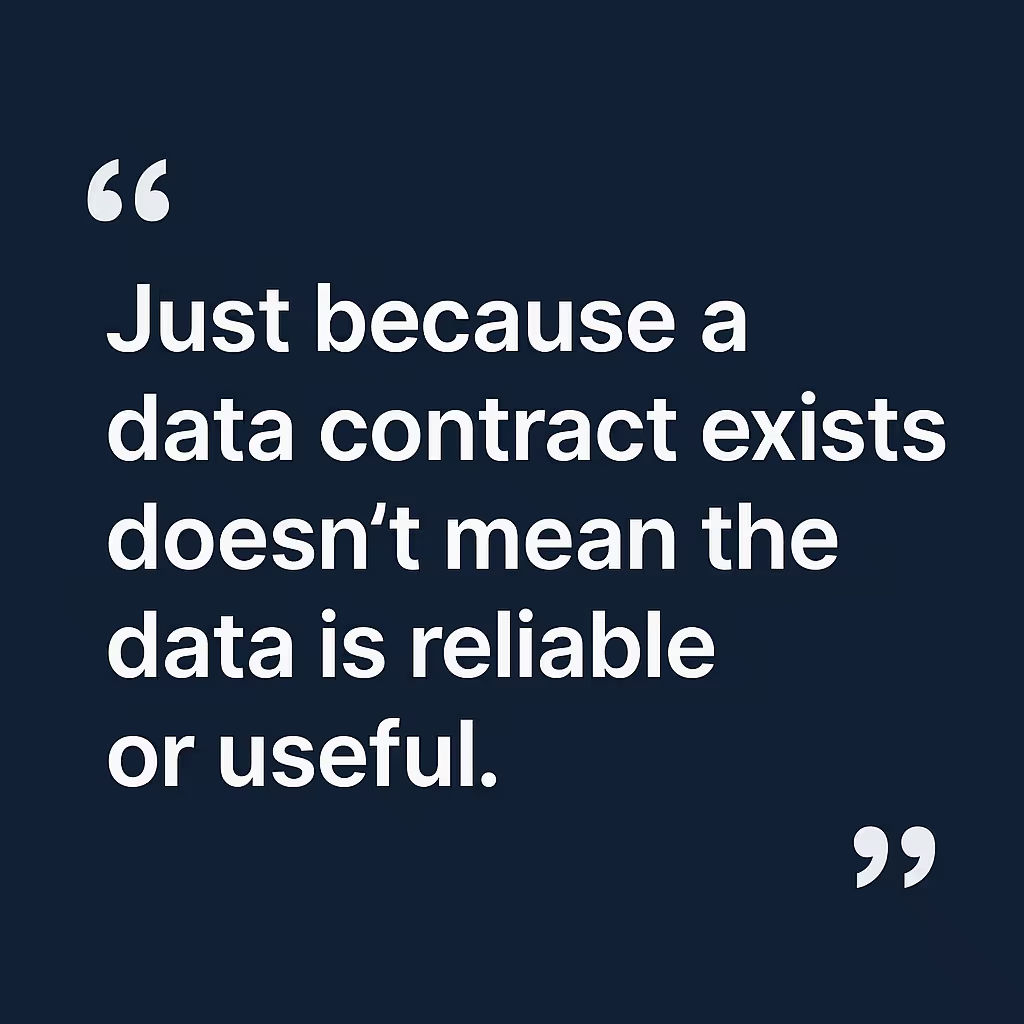Data contracts work in theory, but not in practice.
After four years of widespread adoption, we’re left with YAML files that go stale, schema definitions that drift from business logic, and teams that treat contracts like documentation rather than enforceable agreements.
The fundamental flaw isn’t in the concept.
It’s in the execution.
Static contracts can’t keep pace with dynamic systems as AI becomes more deeply integrated into the modern data stack.
Execution Theater
If you walk into any modern data team, you’ll hear the same story.
Everyone talks about data contracts like they’re already solved. Engineers will point to their dbt schemas with pride while product managers reference “our data contracts” in their roadmap reviews. Leadership will nod approvingly at contract coverage metrics in their QBRs.

The secret? This isn’t much more than execution theater.
If you scratch beneath the surface, you’ll find contracts that haven’t been updated in six months are governing critical revenue pipelines. Worse yet, teams deploy breaking changes on Friday afternoons, leaving those contract updates for the “next sprint”. Data consumers end up building defensive code around contracts they don’t trust, treating them as suggestions rather than guarantees.
The most damning piece of evidence that data contracts work in theory but not in practice? Ask any data engineer how they actually validate contract compliance before a release and watch them squirm. Most can't tell you, because validation happens in a post-deployment panic when dashboards break and stakeholders start asking questions.
We've built an entire industry around the illusion of data governance while the actual machinery of trust operates through Slack DMs, tribal knowledge, and weekend firefighting. The contracts exist in git…but the reliability exists nowhere.
In short, the concept is sound but the execution is often performance art.
From Contract to Context: The AI Ultimatum
If manual contract management is already failing human teams, autonomous AI systems will expose these limitations catastrophically.
While data engineers can patch broken pipelines over weekend Slack threads, autonomous agents making real-time decisions can't wait for humans to update contracts manually or decode tribal knowledge.
AI workloads have made the limitations of traditional data contracts existentially problematic. When your contract validation passes but your LLM starts hallucinating because training data semantics shifted, or your autonomous trading algorithm makes bad decisions because market data contracts didn't capture regime changes, the business consequences aren't just inconvenient, they're potentially catastrophic.
At their core, data contracts were about creating alignment between humans. But alignment doesn't come from documentation, it comes from context, observability, and collaboration. Contracts consistently fail to capture the metadata that AI systems actually need:
- Lineage: What's impacted if this changes?
- Usage patterns: Who's actually using this, and how?
- Business semantics: What does this field mean in context?
- Reliability signals: Can I trust this data right now?
Generative AI applications demand something contracts can't provide: contextual understanding. A GPT-4 fine-tuned on customer support tickets needs to know not just that ticket_category is a string, but that the business logic for categorization changed last month, that certain categories are being deprecated, and that training data from Q3 reflects a different classification schema than Q4.
When an autonomous agent queries customer lifetime value data, it needs to know immediately if upstream ETL jobs are lagging, if the calculation methodology changed, or if the data quality has degraded below acceptable thresholds. It can't wait for a human to notice the problem, schedule a meeting, update documentation, and deploy a fix.
The AI ultimatum is simple: evolve contracts to become contextually aware and machine-readable, or watch them become irrelevant as intelligent systems route around their limitations entirely.
Observability and Metadata Activation: The Trust OS
The solution isn't more sophisticated YAML schemas. It's treating contracts as living components of an intelligent metadata layer—what Sifflet is calling a Trust OS.
This means contracts that are:
- Lineage-aware: When a contract changes, the system immediately maps impact across all downstream consumers, models, and business processes. No more surprise breakages three systems downstream.
- Usage-informed: Contracts enriched with real-time usage patterns can distinguish between critical production paths and dormant experimental pipelines. This context enables intelligent alerting and risk assessment.
- Semantically enriched: Beyond field types and constraints, contracts embed business meaning, calculation logic, and domain context. When revenue changes definition from gross to net, the contract doesn't just validate the new structure—it flags semantic drift to all dependent systems.
- Predictively validated: Advanced observability platforms can now predict contract violations before they occur, using statistical models and anomaly detection to surface drift patterns and suggest proactive remediations.
- Machine-readable: Contracts become API endpoints that AI agents can query for trust signals, data freshness, and reliability scores. This enables autonomous systems to make intelligent decisions about data usage without human intervention.
The technical architecture looks like this: contracts become nodes in a real-time metadata graph, with edges representing dependencies, usage patterns, and trust relationships. Observability engines continuously evaluate this graph, running predictive models to identify potential failures and automatically updating trust scores based on operational reality.
Companies implementing this approach—embedding contracts into platforms for impact analysis, leveraging observability systems like Sifflet for real-time contract monitoring and automated remediation, or building custom metadata APIs on top of systems—are seeing order-of-magnitude improvements in data reliability and stakeholder trust.
The Path Forward
The next generation of data contracts won't be files, they'll be intelligent APIs in a living metadata ecosystem. They'll predict failures instead of just documenting structures. They'll understand business context, not just technical schemas. And they'll enable AI systems to make autonomous decisions about data trust and usage.
This isn't theoretical anymore. The organizations building competitive advantages with AI are already making this shift. They're treating metadata as a first-class product, contracts as living documentation, and observability as the foundation for autonomous data operations.
Because in the end, reliable data isn't built on contracts. It's built on context. And context, at scale, requires intelligence.
The question isn't whether static contracts will survive the AI transformation.
It's whether your organization will adapt quickly enough to capitalize on what comes next.

















-p-500.png)
